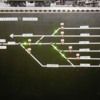As many of you know, I'm building a rather large layout. This layout will feature realistic industrial switching, and car sorting and routing in yards. Where trains can be easily reached, hand uncoupling will be used. Where they can't, electromagnets will be used.
In order to get the quantities I need, I have been buying large lots of 027 remote sections, and straight uncoupler sections for quite a while. I have harvested the electromagnets, and inserted them into GarGraves track.
This is all that's left after the harvest.
Here's what it looks like when the install is done.
Now to the question at hand, what method to activate them?
Option one: Simply use an SPST momentary push button for each magnet. Drawbacks, a lot of holes have to be drilled in the fascia, and they may be be difficult to mount. Also, they can accidentally be leaned on and potentially fried.

Option two: This is a panel designed to be used with a "hot probe". Touch the probe to the head of the carriage bolt to activate the magnet. Advantage, no way to accidentally lean on the button. Disadvantage: one central location, so you may not be near your train to use this.
Option three: (I'm leaning toward this one) Combination of a rotary switch to select which magnet in the area to activate, and a single push button to activate.

I have some large arcade game style buttons.

I could cut small rings out of PVC pipe and glue them to the fascia to keep them from being leaned on.
So, which method do you like?










